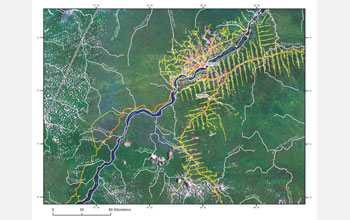Multimedia Gallery
This map illustrates the "fishbone" pattern and the dendritic pattern of forest fragmentat
This map illustrates road patterns identified via satellite imagery, as well as deforested lands. Through NSF funding, Walker and his colleagues are attempting to develop models of the spatial decision-making that generates these patterns in the Amazonian landscape. The roads are represented in yellow, and deforestation in pink. There are two towns: Itaituba, which sits above the Tapajos river, and Trairao, which lies several kilometers south of the river. Below the river, the roads are organized in a parallel pattern. This pattern of parallel roads creates a "fishbone" pattern of forest fragmentation that resembles the bone structure of a fish. The spaces of forest between each road or "bone," allows space for animal movement and adequate ecological conditions.
Above the river, Itaituba is the convergent point from which branches of roads stretch from its center in areas north of the river. The roads are spontaneously constructed in various directions with no obvious organization. This chaotic pattern of roads is called a dendritic pattern, which has a denser network of roads and threatens ecosystems. The spontaneous arrangement of a dendritic pattern suggests that more than one agent was involved in road construction, particularly independent loggers who are less concerned about strategically building roads for sustainable purposes, or for property demarcation.
Credit: Instituto do Homem e Meio Ambiente da Amazonia (IMAZON)
Images credited to the National Science Foundation, a federal agency, are in the public domain. The images were created by employees of the United States Government as part of their official duties or prepared by contractors as "works for hire" for NSF. You may freely use NSF-credited images and, at your discretion, credit NSF with a "Courtesy: National Science Foundation" notation.
Additional information about general usage can be found in Conditions.
Also Available:
Download the high-resolution JPG version of the image. (8.1 MB)
Use your mouse to right-click (Mac users may need to Ctrl-click) the link above and choose the option that will save the file or target to your computer.
Related story: Journey to the Center of the Amazon



